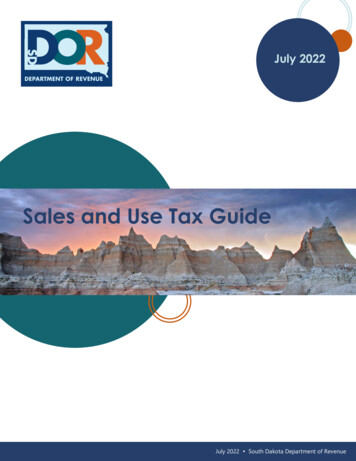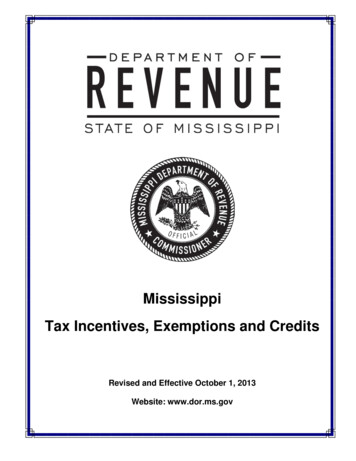
Transcription
Seer Capital Management LP1177 Avenue of the Americas, 34th FloorNew York, NY 10036(212) 850-9000www.seercap.comThe Tax Cut & Jobs Act and Securitized Products;Winners Should Far Outnumber LosersFebruary 2018, Karen Weaver, Seer CapitalOverviewTax reform is expected to be a modest positive for the US economy overall, and for Securitized Productsas well. For Commercial Real Estate, the reform provisions are supportive, though not as dramatic ascorporate tax rate changes, and more a case of retaining existing, favorable tax treatment for CREinvestment. In credit, tax reform is a net positive, though more so for Investment Grade credits than HighYield, and more in the short run than long run. For the housing market, the tax code changes are negative,but in the context of very strong positive momentum and solid fundamentals, reform probably preventsoverheating of the housing market more than anything else. The one pocket most clearly negativelyimpacted by tax reform is redundant to high-value homes in high-tax jurisdictions. These homes are asmall subset of Securitized Products collateral. Further, the negative credit impact for this niche ofhomeowners is unlikely to be material enough to impact their ability to service their debts, or significantlycurtail their spending. However, we may well see home prices stall for this niche. As always, aggregatedimpacts are less useful in assessing risk than granular loan-by-loan analysis, and there will be some netlosers under tax reform (though we expect there to be few). Many analysts believe that the secondaryimpacts of the Tax Cuts & Jobs Act (“TCJA”) on financial policy will prove more important than tax reformitself.The EconomyTax reform has already led to a big jump in 2018 earnings estimates, and should provide a boost tocorporate America, especially given the market’s supposition that central banks will move slowly andcautiously to normalize monetary policy. It remains to be seen how much of the tax cuts are funneled intobusiness investment and/or increased wages, versus share buybacks, M&A and deleveraging, and hencethe extent to which corporate tax cuts will increase growth. The promised “tax holiday” for offshore fundscould provide an incentive to repatriate 2.5 to 3.0 trillion, which could also be stimulative to the extentit is used to expand operations. While tax cuts for households will be stimulative, it is estimated that overthree-fourths of the personal tax cuts will flow to those earning more than 200,000 (the top 5%), whoare less likely to spend on current consumption than other income groups. Street forecasts are for GDPgrowth of 2-2.5%, with upside potential. Moody’s estimates that the tax cuts will add one-tenth to twotenths of a percent to GDP, while others have estimated that reform might add as much as 0.6% to GDPgrowth. Generally lower tax obligations will enhance debt service capacity for corporations andhouseholds; however, there will be credit-negative tax increases on a subset of obligors (again, a smallsubset).At the state level, one can expect increasing resistance to local tax increases as taxpayers lose a significantportion of state and local tax deductions, aka “SALT”. Taxpayers negatively impacted to a material extentby curtailment of SALT deductions might also reduce discretionary spending, shrinking state sales-taxrevenue (the source of 40% of state revenues on average). Other impacts of reform might offset this.While consensus (and the markets) view tax reform as a shot of adrenaline for an already strongeconomy, there are some possible downsides, of course. Because tax receipts will be reduced (Moody’sestimates the tax cuts will cost 1% of GDP on average for the next 10 years), federal deficits may growfaster than previously expected if growth is insufficient to offset lower tax rates. Higher governmentborrowing needs would then coincide with the Fed’s plans to normalize interest rates and stop assetpurchases. This would increase borrowing costs, all else equal. There is also the possibility that tax reformsucceeds “too well”, overheating an economy already at full employment. This would fuel inflationPage 1
Seer Capital Management LP1177 Avenue of the Americas, 34th FloorNew York, NY 10036(212) 850-9000www.seercap.compressures and speed up monetary tightening. Lastly, we are now nine years into recovery and hence at astage when the economy should not need stimulus. By using fiscal stimulus at this juncture, we reduce theoptions in the policy toolbox in the next recession, perhaps exacerbating the next downturn.Impact on Commercial Real Estate/CMBSConsensus at a recent CRE industry conference was positive for 2018, in part because many see taxreform as bullish for CRE. Several participants expressed the view that the stimulus pac kage couldextend the cycle in CRE for another 3-5 years. Expected rent growth fuels this view, in particular formultifamily (as the rent vs. buy equation shifts more toward renting) and for retail (benefitting froma strong consumer). Rising interest rates and the transmission into cap rates are widely viewed asmanageable. A recent study from Standard and Poor’s showed that cap rates are not as highlycorrelated to Treasuries as supposed, especially when rates are relatively low.While the biggest impact of tax reform for CRE is expected to come from the expected boost toGDP, a reduction in taxation for pass-through income is also a positive for the sector. Moreover,highly favorable depreciation of capex also makes it cheaper for CRE investors to retrofit and repositionproperty. Apart from these factors, CRE benefitted as much from a lack of tax reform as anythingelse. That is, some tax provisions that tend to favor CRE had been on the chopping block but endedup being preserved in the final bill. Page 2For example, the tax code allows “Like Kind Exchanges”, by which investors can defer capitalgains on the sale of a property by reinvesting proceeds into another qualifying “like-kind”property. One key change in the new tax bill is that a Like Kind Exchange can only be used todefer capital gains on the value of real property and not personal property (from equipment andfleets to artwork and fixtures).There had also been debate about continuing to allow “Carried Interests” to be taxed at lowercapital gains rates rather than ordinary income rates. After some wrangling, the final bill kept thefavorable treatment for Carried Interests, but increased the minimum holding periodrequirement from one year to three. Most real estate investors hold property for three years ormore in any event. The change could, however, increase tax liabilities for “fix-and-flip” propertyinvestors.Lastly, depreciation rules for real property and improvements were unchanged. At one junctureit was proposed that CRE deprecation be accelerated from 39 years down to 25. While thatwould have been a bonus for CRE, the experience of The Economic Recovery Tax Act of 1981,which greatly sped up CRE depreciation, shows that faster depreciation provided “too much” ofan incentive to invest in real estate development projects and led to an overbuilding boom--andeventual bust.One of the most attractive elements of the recent tax reform is the treatment of “Pass-throughincome”. The change impacts individuals and family trusts investing in real estate throughpartnership entities, such as LLPs and private equity funds, and REIT investors. Owners of a passthrough entity report the business’s income on his or her individual tax return. Under the newtax law, they may now claim up to a 20% deduction. For example, if an LLP owns a property thatgenerates 100,000 in income to its investor partners, those investors could avoid paying taxeson as much as 20,000. While the stated intent behind this tax provisions is to create jobs (bycount, nearly 95% of US businesses are structured as pass-through entities, and most all smallbusinesses are), the provision also allows real estate investors to benefit from the deduction. Asa result, the changes in the tax code might usher in changes in ownerships structures for CRE.Though business owners in a pass-through entity will see their tax rate drop from 39.6% to 29.6%(i.e. the new top rate of 37% x (100% less the new 20% deduction), the corporate tax rate will
Seer Capital Management LP1177 Avenue of the Americas, 34th FloorNew York, NY 10036(212) 850-9000www.seercap.com also drop significantly--from 35% to 21%. This begs the question: should taxpayers form acorporation rather than a partnership? The answer will depend on other factors, such as howtheir cash flow is treated, how frequently cash is pulled out, and the arcane particulars of thenew tax laws that must be met in order to get the full 20% deduction. Lastly, many of the new taxprovisions are not permanent and will expire in ten years if not extended by Congress, and anyshift in power in Congress could even spark a roll-back. In any event, the pass-through incomededuction does improve the economics for many CRE investors and creates incremental demand.Interestingly, new limitations on the deductibility of interest on corporate debt may have anunintended consequence. Going forward, corporations may be more inclined to own their realestate, as mortgage debt remains fully deductible whereas corporate debt now has limitationson deductibility. This could also create incremental demand for CRE.Impact on Residential Real Estate/RMBSTax reform was not kind to the housing market, but housing is currently so robust that these changes arenot likely to lead to significant negative consequences for the market as a whole. The tax reform actincludes four provisions that negatively impact the tax advantages of homeownership, while at the sametime reducing income taxes more broadly for many.1. A near doubling of the standard deduction, which for the average household (e.g. making 50,000/yr.) would make it less attractive to itemize deductions and thus reduce the attractionof the mortgage interest deduction. These borrowers may be more likely to rent going forward.This could be a negative for new home construction, which has never recovered to normal levelsand has already been far less of a contributor to the broad economy than in typical recoveries.2. A reduction in the Mortgage Interest Deduction (MID) cap from 1mn of indebtedness down to 750,000 of indebtedness (with grandfathering). This will have a modest negative impact on anaffordability for a small subset of high-value potential homebuyers in the higher price tiers.3. New limits of the interest deduction for home equity loans, including any existing loans/lines(i.e. without grandfathering). In late February, the Internal Revenue Service clarified this point.From 2018 to 2026, interest is tax deductible on home equity loans if (and only if) it is used to“buy, build, or substantially improve the taxpayer’s home that secures the loan.” Until this year,borrowers were also allowed to deduct interest on up to 100,000 in HELs and HELOCs,regardless of the use of proceeds.4. A new cap on the aggregate deduction for all state and local sales, income, and property taxes(“SALT”), of 10,000. State and local taxes paid in 2015 (the most recent available) totaled 1.5trillion, and 550bn of that was deducted from individuals’ income taxes. Nationwide, 30% oftaxpayers take SALT deductions; in states like NY, NJ and CT, the statewide average is 40%. NewYork state’s average SALT deduction amount is the highest in the nation, at 22,000. InWestchester county 73% of residents pay at least 10,000 in property taxes alone, on top of highstate and local tax burdens. While the vast majority of taxpayers will not be affected, in certainprice tiers in a handful of markets, this change in the tax code could prove to be a materialnegative for home price appreciation.5. It is also worth noting that the individual tax cuts are not permanent but will expire at the endof 2025. Because the tax reform bill did not include enough sources of revenue to offset its 1.5trillion cost, Congress was unable to make most of the individual tax cuts permanent. The path ofleast resistance would be to allow the individual tax cuts to expire, with a net result that manyindividual tax payers will be worse off in 2026.Page 3
Seer Capital Management LP1177 Avenue of the Americas, 34th FloorNew York, NY 10036(212) 850-9000www.seercap.comWhile these changes to the tax code are clearly negative for home prices as a matter of simplemathematics, it is not widely expected that tax reform will be particularly harmful to the broad housingmarket, for a number of reasons. Chief among those reasons is the context of these changes, i.e. a veryrobust housing market. Home prices have risen for 68 consecutive months, and momentum is strong, withthe rate of appreciation accelerating. Affordability is solid, confidence is high, and inventories are verylow. Nationwide, inventory is at 3.2 months, a record low and about half what is considered “normal” in astable market. Household formations are high, and homeownership increased 2% YOY last quarter, thehighest rate of growth in 13 years. Unemployment is low, wage growth is picking up, and mortgagelending continues to ease. The prospect for a pick up in inflation also incents homebuyers to jump insooner. With all of these positives, and given the fact that the magnitude of the new tax provisions ismodest for all but a small subset of homeowners, it seems unlikely that the TCJA would lead to asignificant, nationwide home price decline. A recent Moody’s Analytics study looked at 20 housingmarkets they believe could suffer price erosion due to tax reform. Post-crisis prime RMBS transactionshad an average exposure of 3.4% to those markets, while Fannie Mae and Freddie Mac credit-risktransfer RMBS had an average exposure of 2.1%; clearly this is a niche issue.Among street analysts, the expectation is that tax reform shaves perhaps 1% off of next year’s HPA,moderating from 5% to 4%; of course higher mortgage rates will also come in to play. Moody’sAnalytics is considerably more bearish, suggesting that tax reform would reduce HPA by 4% nationwideover the next year. Most obligors will be in a slightly better position to meet their financial obligationspost-tax reform. For those niche households that are materially negatively impacted by housing-relatedtax-reform, other aspects of the act may well be a net positive for them. Of course, that may amelioratethe impact of any given borrower’s financials, but it does not soften the blow to home prices in highvalue-high-tax areas, which will simply become less economical to own.At their core, these tax changes alter the economics of home owning for many. The actual reduction inhomeownership incentives depends on the level of income, marginal rates, mortgage interest, propertytaxes, family size and the standard deduction. An analysis by the Urban Institute estimated breakevenannual rent for four groups of hypothetical borrowers, with incomes of 50K, 75K, 150K and 300K. Forthe lowest income example, the change in the tax code did not impact the rent vs. buy equation.However, for the highest income borrower, a 300,000 income household buying a 1.2mn home, annualbreakeven rent went from 33,086 under 2017 tax law, up to 43,570 under current law, a 32% jump.This augurs well for luxury multifamily and poorly for the value of high-end homes. While prominenthousing economists such as Robert Shiller will argue that homebuyers are irrational and react slowly topolicy, the magnitude of these figures for the top of the market is hard to dismiss. It is true that manyfactors influence the traditional preference for buying, including upside potential, inflation hedging,forced savings, better selection of housing stock for purchase than for rent, and the availability ofleverage on good terms. However, none of these factors are new; what is new is less favorable taxtreatment for homeowners.As it relates to Securitized Products, again, most of the underlying housing stock will only be marginallyimpacted if at all. For example, of 382 MSAs, there are only 26 where high value homes (defined here as 750K) make up even 10% of the market. Those are areas that might be impacted by the new cap onMIDs. There are only 19 counties (of 3142) where average property taxes exceed 10,000. Notsurprisingly they are mostly in the NYC Metro, New York and New Jersey; southern Florida; coastalCalifornia; and, to a lesser extent, Chicago and Texas.The change in the MID cap impact is fairly easy to measure. If we assume the worst case, i.e. a householdwith a mortgage of 1 million moves houses and becomes subject to the new 750k indebtedness cap,Page 4
Seer Capital Management LP1177 Avenue of the Americas, 34th FloorNew York, NY 10036(212) 850-9000www.seercap.comthey lose the ability to deduct interest on 250,000 of their mortgage debt. Using current rates, thatwould be a 10,000 deduction. Assuming a marginal tax rate of 30%, this borrower would take a 3,000after-tax income hit in year one of the mortgage. This is not particularly onerous given the level of incomeneeded to qualify for a 1mm mortgage. Notably, home purchase above 750,000 are only about 7% ofall transactions. Moreover, at these price points buyers are less likely to use financing than the medianbuyer. Because the MID is grandfathered, one of the more important impacts may be on mobility, withsome high-end borrowers less willing to sell because it would reduce the subsequent deductibility of theirmortgage interest. This could be one silver lining for higher value homes, if it limits the supply of existinghomes for sale (all else equal, this would be constructive for home prices). On the other hand, somehigher – value owners may choose to sell due to the curtailment of the SALT deductions.It is also worth noting that, even where tax reform is negative for housing, the net impact of all the taxreforms may be positive for the household. For example, one street firm estimated that changes inhousing-related tax policies could reduce income for jumbo borrowers in California and New York by 3 to5%. However, the same firm noted that, in many cases, favorable changes to the Alternative MinimumTax (AMT) will more than offset the loss of MID and SALT deductions. In addition, many high-incomehouseholds will benefit from the cuts to corporate and individual income tax rates, and reduced taxes onpartnerships. Although the personal income tax analysis is complex and requires a number of simplifyingassumptions, one research group summed it up succinctly. Generally, households earning 50-85K willbenefit from the higher child tax credit, households in the 100-200K income bucket will get hurt by theSALT and MID caps, while those households earning 200K will benefit from the higher AMT exemption.The “AMT” or “Alternative Minimum Tax” is a mandatory alternative to standard income tax, triggeredwhen a taxpayer’s income exceeds a stipulated level. AMT eliminates many deductions a taxpayer wouldotherwise take, but for hitting the AMT threshold income. AMT was intended to prevent high incomeearners from utilizing very high deductions to pay little or no income taxes. Essentially taxpayers calculatetaxes twice, once for “regular” income tax, and once for the AMT—and then pay the higher amount. AMTmeans that taxpayers are not getting the full benefit of their deductions.The new tax law raises the AMT standard exemption from 84,500 to 109,400 for joint return filers. Thatexemption phases out at higher income levels. The phase-out started at 160,900 under old tax law, butunder the new bill the phase-out starts at 1,000,000. So, while tax reform cut MID and SALT deductions,in fact those deductions had always been somewhat illusory for many taxpayers due to the AMT. Byreducing MID and SALT deductions while also making the AMT less onerous, the tax act has taken awaywith one hand, and given back with the other. The more generous AMT rules reduce taxes and sosomewhat salve the wounds for the taxpayers who are losing some of their SALT deductions. But a lowerAMT does not change the fact that these shifts in the taxation paradigm make high-value-high-tax housinga significantly less attractive investment and hence make it vulnerable to price declines, all else equal.Which housing markets, specifically, appear most vulnerable? Moody’s Analytics projected that theimpact of the new tax code in Manhattan could reduce home price appreciation there by as much as 10%over the next 18 months. Already we have seen a slowdown in activity, with the pace of sales down 12%YOY in Manhattan, arguably reflecting a disagreement between buyers and sellers about home values inthe new tax regime. Since the change in SALT deductions is the most significant reform, those areas withthe highest average SALT deductions are most vulnerable to softening (see below). It remains to be seenwhether any softening will be confined to the higher price tiers, or whether it will have a “trickle down”effect on lower-priced homes as well. Moreover, these counties may come up against a stronger anti-taxsentiment going forward, possibly jeopardizing the very amenities (like schools) that drove the highproperty valuations in the first place, and also reducing their flexibility to back-fill any federal governmentPage 5
Seer Capital Management LP1177 Avenue of the Americas, 34th FloorNew York, NY 10036(212) 850-9000www.seercap.comcutbacks. Lastly, by widening tax rate disparities among states and metro areas, these tax reforms maymake it harder for high-tax regions to attract businesses and hence lower their potential growthtrajectory.Top Ten Counties for State and Local Tax Deductions 2014*New York County, NYMarin County, CASan Mateo County, CAWestchester County, NYFairfield County, CTSanta Clara County, CASan Francisco County, CANassau County, NYMorris County, NJSomerset County, NJ 24,898 16,956 15,405 14,784 14,262 12,562 12,116 11,624 11,440 11,267* Source: IRS Tax Stats – County DataOne analyst suggests that, within the subset of high-value-high-tax housing markets, of particular concernare markets where homeowners have a long tenure in their current homes. These homeowners may beon the verge of downsizing, and the increased after-tax SALT burden might expedite that process.Moreover, because of that long tenure in their homes, they may have very large paper gains and be morewilling than recent buyers (with smaller or no gains) to sell “below market” in order to reduce theirproperty tax burden. If we choose the year 2000 as a cutoff, 27% of US homeowners moved into theircurrent home before 2000. In one NYC metro market, that figure is 45% (see below). This might suggest aunique vulnerability. However, all of the aforementioned strengths of the housing market are possibleoffsets to these headwinds. High-value-high-tax markets have some unique factors that are supportive aswell; e.g. rapid job growth in CA markets, a strong bonus season in the NY metro, and in both markets, asignificant cohort of investors with stock market exposure, who may prefer investing in real estate at thisjuncture.Counties Surrounding NYC*CountyNew York County, NYMarin County, CASan Mateo County, CAWestchester County, NYFairfield County, CTSanta Clara County, CASan Francisco County, CANassau County, NYMorris County, NJSomerset County, NJ% Movedin 200045%35%34%35%39%32%31%41%34%41%% ValuedAbove 500k43%52%43%39%35%39%41%31%35%26%* Source: US Census Bureau, FHFA, Morgan Stanley ResearchPage 6HPASince 200070%59%61%50%55%52%32%35%67%65%
Seer Capital Management LP1177 Avenue of the Americas, 34th FloorNew York, NY 10036(212) 850-9000www.seercap.comAt the end of the day, there are three things that will determine how tax reform impacts the housingmarket.1. First, what is the net impact on after-tax income and hence affordability? The answer is,generally positive. But there are some important caveats. In markets like coastal California,where a lot of households are in the 100-200K income bracket, they are likely be net losers fromtax reform.2. Tax reform has increased the relative attractiveness of renting vs. buying. All else equal thatshould reduce demand and hence reduce the equilibrium price of housing.3. How well understood is the impact of tax reform, and is the tax paradigm expected to remainstatic? Under the old tax law, for example, SALT deductions were fully deductible withoutlimitation. However, as discussed above, for many higher income borrowers, those SALTdeductions (as well as other deductions) were often illusory after taking into account the AMT.For anyone impacted by AMT, their SALT deductions were already curtailed under the old taxcode, even if that was not clear because it was not expressly stated as such but effectuatedthrough AMT. It is unclear how many buyers truly know (or will much care) exactly how taxreform has impacted their cost of ownership.Impact in Leveraged Loans/CLOsThe tax reform act is generally positive for corporate credit. Corporate borrowers should benefit from theact’s stimulative impact on the broad economy and, for the vast majority, lower tax bills. TCJA alsoprovides incentives for corporations to de-lever, which could reduce debt supply (providing a positivetechnical). The greatest beneficiaries of reform will be investment-grade issuers and cross-over credits,however, who are more likely to use incremental cash flow for dividends and buybacks, capitalinvestment, and M&A than for debt reduction. For those companies which are negatively affected by taxreform, we may see adjustments in their capital structure and de-leveraging. But while the new tax codeincreases the after-tax cost of debt, we expect adjustments will be largely on the margin. Debt will remainan attractive form of capital, even with less favorable deductibility.While undeniably bullish for the credit sector in aggregate, tax reform will not benefit all companiesequally. The impact of the changes will depend on the borrower’s effective tax rate under the old tax law,the nature of the industry in which it competes (especially as it relates to capital spending requirements),and the extent of any overseas operations. On the “con” side of the ledger, there is some concern that taxreform may prove inflationary and lead to tighter monetary policy. There is also concern that, over thelong run, the new cap on interest deductibility will be pro-cyclical (that is, could make any futuredownturn worse). Lastly, some argue that fiscal stimulus like tax cuts should have been “saved” to use ifand when the economy enters a recession, and that we may have squandered a valuable tool that couldhave helped soften a future downturn.There are four key elements to corporate tax reform. Two are designed to be stimulative, one is designedto reduce corporate leverage, and one is designed to increase tax revenues. They are:1. The most dramatic change is a permanent reduction in the corporate statutory tax rates, to21% from 35%. Unlike many other provisions of the new code, this does not sunset.2. The TCJA also provides full, upfront depreciation of capital expenditures, a further break forcorporations. Starting in 2018, one-hundred percent of capex investments can be deducted inthe year incurred (with that perk scaling back in 2023 to 80% deduction in year one and in 2024to 60%, and so on). The more capital-intensive sectors (autos, telecommunications, utilities),definitionally, will benefit most from this provision.Page 7
Seer Capital Management LP1177 Avenue of the Americas, 34th FloorNew York, NY 10036(212) 850-9000www.seercap.com3. and 4. Less favorably, corporate tax reform also includes caps on deductions for interestexpense and caps on the use of net operating losses (NOL’s). For the first three years interestdeductions will be capped at 30% of EBITDA. In 2022, the interest expense deduction is scaledback further, as the cap switches from 30% of EBITDA to 30% of EBIT. In addition, NOLs will belimited to 80% of taxable income. NOL carrybacks are no longer allowed, but carry forwards,which had been limited to 20 years, can now be carried forward indefinitely.By reason, those sectors with high effective tax rates today have the most to gain from the dramaticreduction in the statutory rate. But most borrowers won’t truly receive the full, headline 14-percentagepoint drop in corporate tax rates. According to the Treasury Department’s Office of Tax Policy, aftervarious deductions and deferrals the average effective corporate tax rate in 2014 (the latest available)was 24%— far closer to the new 21% rate than the old nominal rate of 35%. Keep in mind, as well, thatthe value of any deductions going forward will also be lower with a lower statutory rate in place. Thatsaid, net-net, corporations are still clearly significant beneficiaries of tax reform via both lower tax ratesand the immediate expensing of capital expenditures.Limits on the deductibility of interest expense are a headwind for some borrowers in Leveraged Loans andHigh Yield, but this may be less detrimental than it seems. Many highly leveraged issuers—especiallyleveraged buyouts, which currently make up nearly half of Leveraged Loan volumes— will not have taxobligations in any event. Other issuers, such as in the Oil and Gas sector, for example, have accruedextensive net operating losses (NOLs) after the last several years of difficult conditions in that industry.Some estimate that a full 30% of speculative-grade issuers don’t pay taxes at all and will not under thenew tax law as well.That said, clearly some Leveraged Loan borrowers are likely to incur higher taxes due to the new limits oninterest deductibility. The positive effects of tax reform are greater for investment-grade borrowers(those rated ‘BBB-‘ and higher) than for speculative-grade ones (‘BB ’ and lower). Colla
February 2018, Karen Weaver, Seer Capital Overview Tax reform is expected to be a modest positive for the US economy overall, and for Securitized Products as well. For Commercial Real Estate, the reform provisions are supportive, though not as dramatic as . Seer Capital Management LP Floor New York, NY 10036 (212) 850-9000 www.seercap.com .











